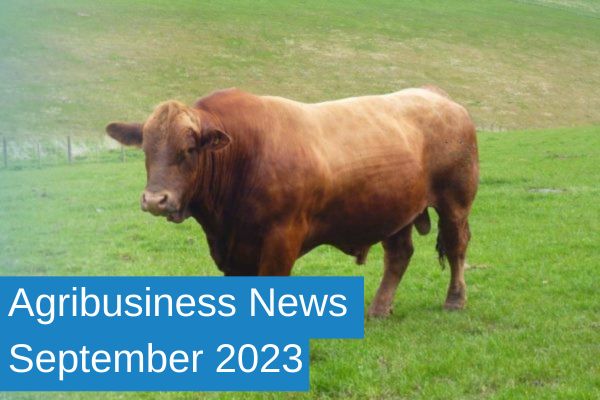Agribusiness News September 2023 – Sector Focus: Bull Fertility
1 September 2023Improving fertility with semen testing
Performance of suckler herds has never been more important as increased input costs continue to put pressure on businesses and squeeze margins. Improving on-farm efficiencies such as herd fertility strongly correlates with reduced production costs per kg of beef sold. Improving performance within a beef herd relies on optimal fertility.
Many farmers have taken advantage of the attractive cull cow price over the past 18 months, opting to cull poor and underperforming animals in order to improve efficiency. However, how many farmers have semen tested stock bulls to identify underperforming and sub fertile bulls? Sub fertility can affect up to 25% of bulls, with there being no guarantee that a bull will retain fertility from one breeding season to the next.
Therefore, it is vital that you are know bulls are capable of doing their job. For those herds who are rotating bulls, the severity of bull infertility could well be masked, as you may not be aware there is an issue and can still be losing performance.
Bull infertility is costly, resulting in reduced calf output through having less calves to sell and lighter calves at weaning due to calves being born later (bull fertility is key to maintaining a tight calving period). When the cost of heifer replacements is considered then the potential cost of one bull’s reduced fertility could run into thousands of pounds. This can easily be increased if there is more than one sub-fertile bull in the herd. To ensure suckler cow fertility is not comprised semen testing is an essential part of maximising herd performance and calves reared.
Funding for testing
In a 3-year trial run by SRUC Vet Iain McCormick, it has been found that on average, 1 in 5 bulls fail a fertility test irrespective of age or breed, with young bulls failing as much as older stock bulls. Routine annual testing of bulls is something which more herds are carrying out. There is funding available for assessment of bull fertility and bull pre-breeding examinations as part of the Scottish Government’s ‘Preparing for Sustainable Farming’ under the animal health and welfare interventions aimed at better production efficiency.
For more information see: https://www.ruralpayments.org/topics/all-schemes/preparing-for-sustainable-farming–psf-/ and consult your vet if you are interested in bull fertility testing.
With the autumn bull sales only weeks away, now is the time to semen test stock bulls, so problems can be picked up on and a new stock bull bought ahead of the next breeding season. For those bulls still running with cows, semen test when bulls are taken out, as pregnancy scanning reports a historic event, and so will not prevent the problem of empty cows, if bull fertility is the problem.
Bull selection
Buying a stock bull is an important decision. Breeding decisions made at these autumn bull sales will impact the herds productivity and efficiency for the future. A bull bought in 2023 will not have calves on the ground until 2025 with these calves not finished until 2026 at the earliest. If heifer calves are retained for breeding, their calves won’t be on the ground until 2027 at the earliest. Breeding decisions made today have a major impact on the future of a herd, therefore it is important that farmers look to the future. Take time to evaluate what bulls at the upcoming autumn sale offer your herd, to ensure the investment will have a positive impact. Remember a bull bought to breed heifer replacements, will have his genetics in the herd for potentially the next 10 years.
The use of EBVs can help when choosing a stock bull to identify how the bull’s offspring should perform productively. EBVs are not comparable across different breeds, the figures allow comparison of genetic traits of bulls within a breed type. All breeds have different values as their average. The importance of EBVs will depend on whether the bull is being selected as a terminal or maternal sire.
These figures should be used alongside visual assessment of the bull considering conformation, locomotion, scrotal size and shape. Scrotal size is linked to fertility. Bulls with increased scrotal size are likely to produce males with increased sperm quantity and quality with earlier puberty in heifers being strongly linked to the scrotal circumference of their sire.
The BCVA Bull Pre-Breeding Examination Certification Guidelines for age and minimum scrotal size are:

sarah.balfour@sac.co.uk
Sign up to the FAS newsletter
Receive updates on news, events and publications from Scotland’s Farm Advisory Service

